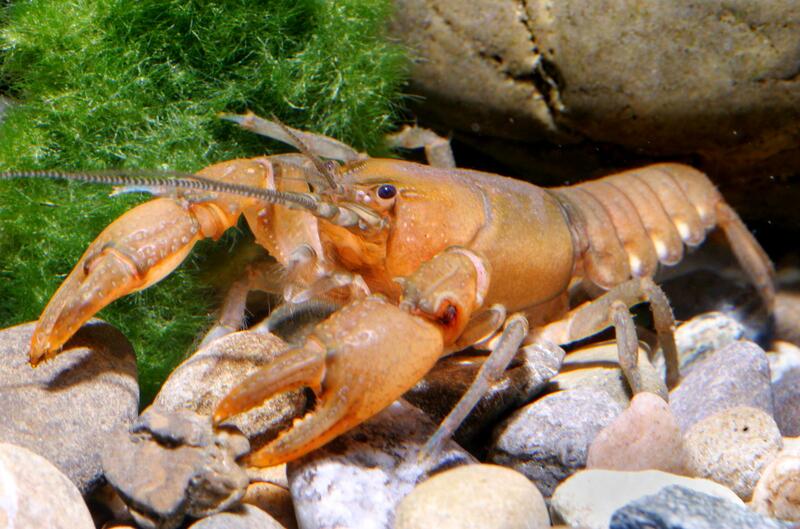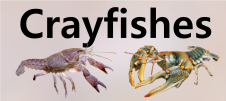







Loading profile. Please wait . . .
Cambarus parvoculus Hobbs and Shoup, 1947
Mountain Midget Crayfish




Federal Protection: No US federal protection
State Protection: No Georgia state protection
Global Rank: G5
State Rank: S3
Element Locations Tracked in Biotics: No
SWAP 2015 Species of Greatest Conservation Need (SGCN): No
SWAP 2025 Species of Greatest Conservation Need (SGCN): No
2025 SGCN Priority Tier: None
Element Occurrences (EOs) in Georgia: 5
Habitat Summary for element in Georgia: Swift clear streams with substrate of bedrock, sand, or gravel
The overall color of the Mountain Midget Crayfish is brownish or olive with no distinguishing markings. The claws have a single row of well-developed tubercles along the mesial margin of the palm. The areola is fairly wide and the rostrum is short and wide and has no marginal tubercles or spines. A single cervical tubercle is usually present. This species reaches a maximum total body length of about 64 mm (2.5 in).
The only other crayfish that has been collected with Cambarus parvoculus in Georgia is the Blackbarred Crayfish, Cambarus unestami. This species has two rows of tubercles along the mesial margin of the palm and is brown or tan with dark mottling.
The Mountain Midget Crayfish is a stream dweller and is usually found among rocks or woody debris in slower moving areas in streams.
No studies of the Mountain Midget Crayfish are known. Crayfishes are considered opportunistic omnivores and likely feed on live and decaying vegetation, aquatic insect larvae, small fishes, and dead animal matter.
Stream dwelling crayfishes typically hide during the day and come out at night to feed. Reproduction usually occurs during the spring and fall, but males in reproductive condition may be found at any time during the year. When female crayfish are ready to lay eggs, they usually find a secure hiding place and hence are rarely encountered. When the eggs are released, the female attaches them to her swimmerets and is said to be "in berry." Upon hatching, the juvenile crayfish are attached to the mother by a thread. After the juveniles molt for the second time, they are free of the mother, but stay close and will hold on to her for some time. Eventually they move off on their own. Crayfishes molt 6 or 7 times during their first year of life and most are probably able to reproduce by the end of that year. They molt once or twice a year for the remainder of their lives and live about 3 years. Male Mountain Midget Crayfish in reproductive condition have been collected in October in Georgia and no females with eggs or young have been found in the state. The smallest reproductive male from Georgia is about 58 mm (2.3 in) in length (Hobbs 1981).
This species can be collected by carefully removing large rocks (or other debris) in slower flowing areas and pools and either pinning the crayfish by hand or coaxing into a dipnet. The use of minnow traps set overnight would probably be effective as well.
Mountain Midget Crayfish is found primarily on the Cumberland Plateau in Tennessee and barely makes it into Georgia in the northwestern portion of the state. There it inhabits small to medium sized streams that flow westward to the Tennessee River (Hobbs 1981, 1989).
Heavy sedimentation resulting from poor development and land management practices may cover substrates and other daytime hiding places on which crayfishes rely to avoid predation. The introduction of non-native crayfishes is a threat to all native crayfishes.
Despite the somewhat narrow range of this species, it is thought to be stable in Georgia at this time.
Conserving populations of the Mountain Midget Crayfish will require general watershed level protection measures, including the protection of riparian zones, control of sediment and nutrient runoff from farms and construction sites, and limiting the amount of impervious cover (e.g., pavement) within occupied watersheds. Non-native crayfishes should never be used for bait; instead, anglers should use crayfishes collected from the river system where they will be fishing. Unused bait of any kind should not be released back into Georgia waters.
Hobbs, H.H., Jr. 1981. The crayfishes of Georgia. Smithsonian Contributions to Zoology 318:1–549.
Taylor, C.A., G.A. Schuster, J.E. Cooper, R.J. DiStefano, A.G. Eversole, P. Hamr, H.H. Hobbs III, H.W. Robison, C.E. Skelton, and R.F. Thoma. 2007. A reassessment of the conservation status of crayfishes of the United States and Canada after 10+ years of increased awareness. Fisheries 32:372–389.
Christopher E. Skelton
C. Skelton, 2012: original account
C. Skelton, February 2019: general update of account.